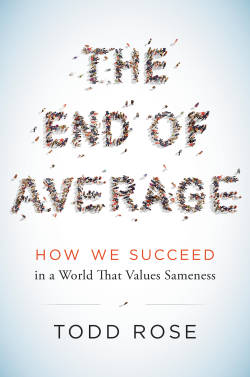Excerpted from The End of Average: How We Succeed in a World That Values Sameness by Todd Rose. Copyright ©2016 by L. Todd Rose, published by HarperOne, an imprint of HarperCollins Publishers.
I hope I have captured just how incredible a pilot Killer C is. But I would never be telling you this story if the U.S. Air Force still insisted that our pilots fit inside a cockpit designed for an average pilot: Colonel Kim N. Campbell, whose real call sign is Killer Chick, is five foot four and weighs 120 pounds—and she could not be any further from someone’s idea of an “average” pilot.
There is an important lesson here about the nature of opportunity. When the military adopted Lieutenant Gilbert Daniels’s radical idea of creating adjustable cockpits that fit any person’s body, nobody was talking about expanding the pool of pilot talent, let alone advocating for gender equity. They just wanted their existing pilots to perform better. The air force did not get Campbell because they designed a female-friendly plane, they got Campbell because they made a commitment to build planes designed to fit the jagged profile of individual pilots, whatever their jaggedness might be. “When I climb into the Warthog,” Campbell said to me, “the seat needs to go to its maximum height and the pedals go all the way back—but it fits.”
This is the lesson of Kim Campbell: fit creates opportunity. If the environment is a bad match with our individuality—if we cannot reach the controls in the cockpit—our performance will always be artificially impaired. If we do get a good fit with our environment—whether that environment is a cockpit, a classroom, or a corner office—we will have the opportunity to show what we are truly capable of. This means that if we want equal opportunity for everyone, if we want a society where each one of us has the same chance to live up to our full potential, then we must create professional, educational, and social institutions that are responsive to individuality.
 This is not how we usually think about equal opportunity. During the Age of Average we have defined opportunity as “equal access”—as ensuring that everyone has access to the same experiences. Of course, equal access is undoubtedly preferable to older alternatives such as nepotism, cronyism, racism, misogyny, and classism. And there is no doubt that equal access has improved society immensely, creating a society that is more tolerant, respectful, and inclusive. But equal access suffers from one major shortcoming: it aims to maximize individual opportunity on average by ensuring that everyone has access to the same standardized system, whether or not that system actually fits.
This is not how we usually think about equal opportunity. During the Age of Average we have defined opportunity as “equal access”—as ensuring that everyone has access to the same experiences. Of course, equal access is undoubtedly preferable to older alternatives such as nepotism, cronyism, racism, misogyny, and classism. And there is no doubt that equal access has improved society immensely, creating a society that is more tolerant, respectful, and inclusive. But equal access suffers from one major shortcoming: it aims to maximize individual opportunity on average by ensuring that everyone has access to the same standardized system, whether or not that system actually fits.


